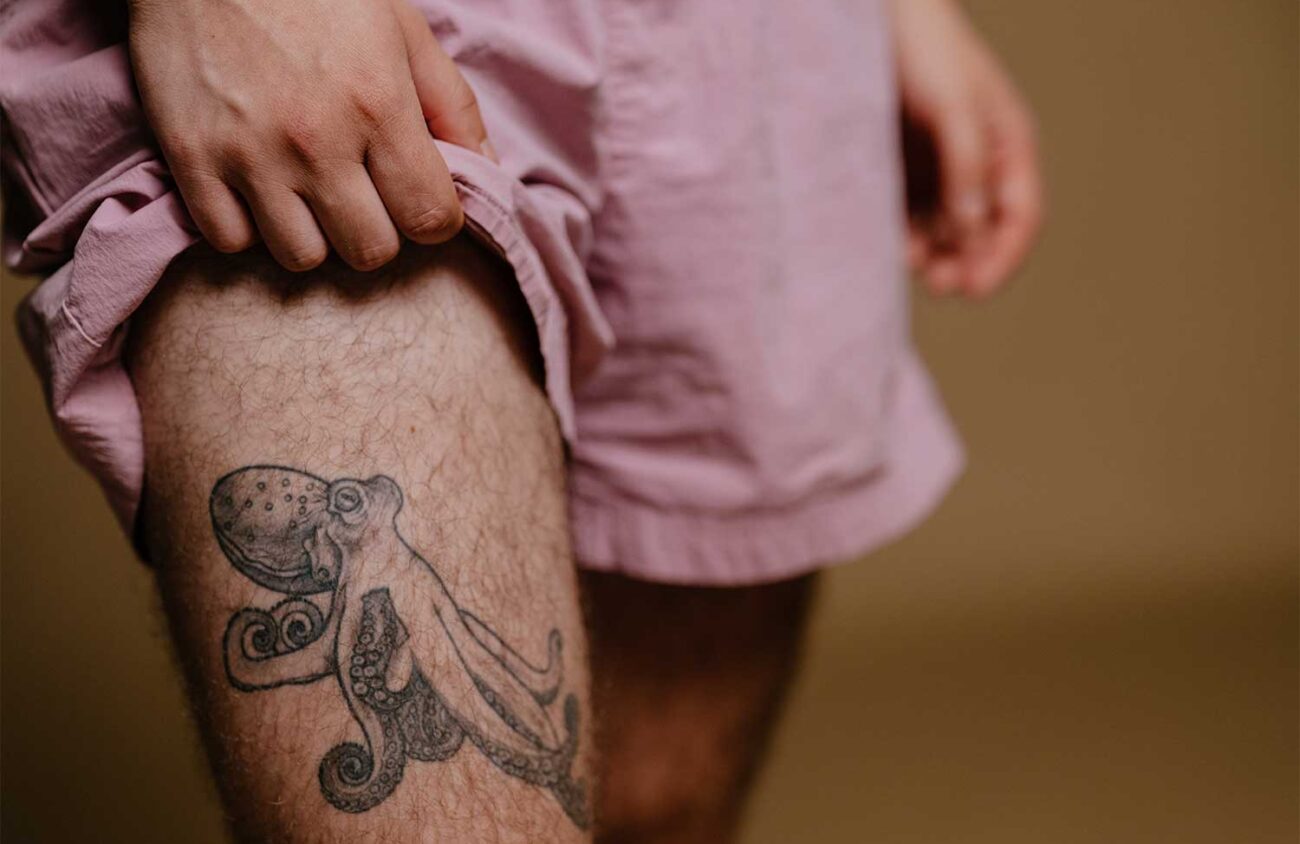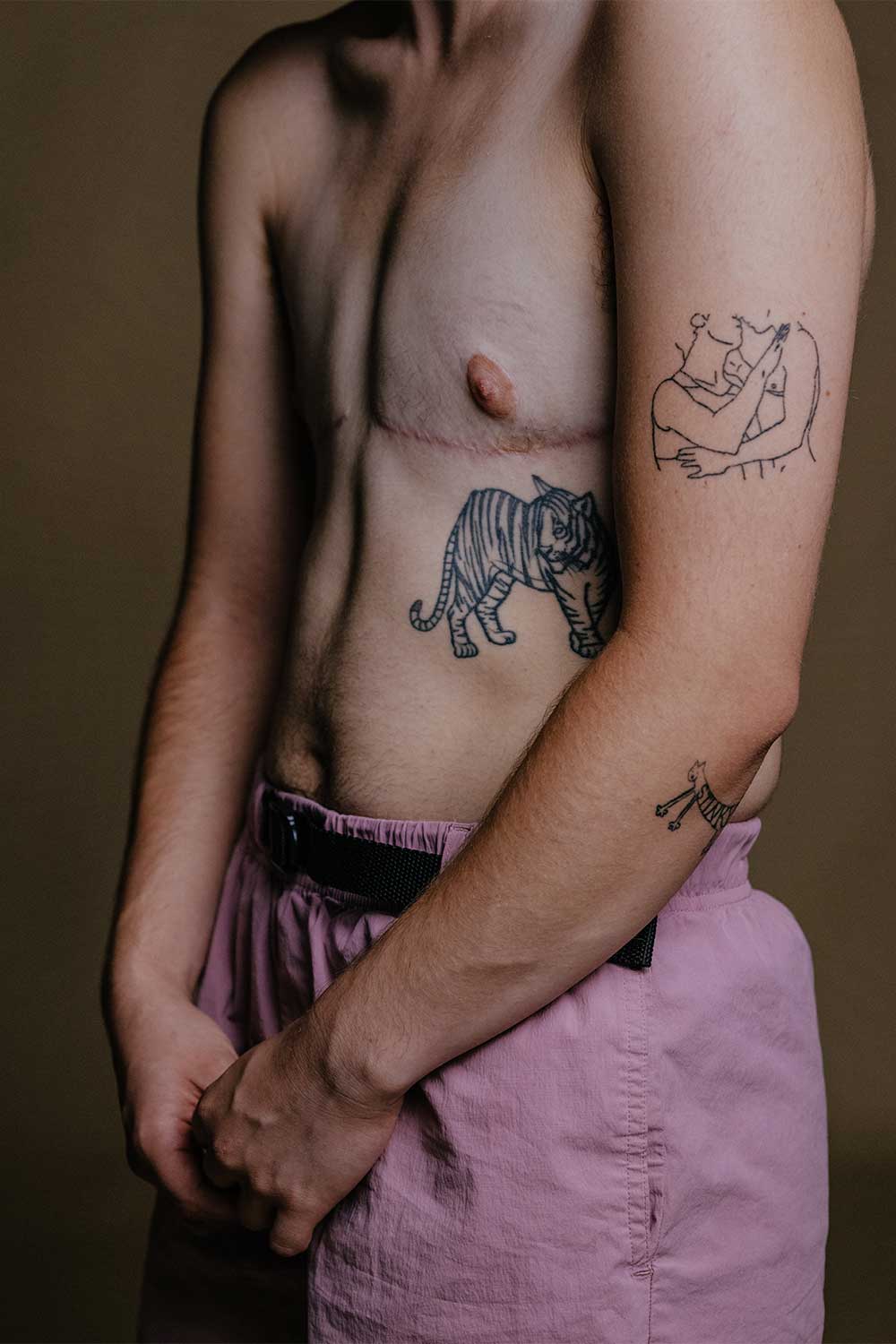The second time I remember experiencing gender euphoria was when I got my octopus tattoo.
The first time was earlier that year — January 2021, specifically — when I finally admitted to myself that I wanted top surgery and bought my first binder. I remember wriggling into it, patting my shirt down over my chest and jumping on Zoom office hours with a professor. I was lightheaded (the binder wasn’t stretched out enough to fit my torso yet) and my professor couldn’t see below my shoulders, but I felt a giddy groundedness in my body.
Seven months later, I had an octopus tattooed on my right thigh. I was still unpacking all my internalized biases about going on testosterone, and my top surgery consultation was scheduled two years out, but I felt that same sense of freedom and embodiment again. Adorning myself with an image in a place I could see helped me feel autonomy in a body that I felt so foreign in.
As I talked to other trans people in my life, I learned I wasn’t the only one.
“Have you really met any trans or queer person over 18 who doesn’t have tattoos or doesn’t want tattoos?” says Grayson Colbert, a New York City-based fine artist and tattooer who did my most recent ink in July.
“Before I was able to have control of my appearance through transitioning, I was able to do so with tattoos,” former University of Oregon student Ian Miller says. “They made me gain confidence in myself and feel at home in my body while I waited for the long process of transitioning. To this day, my tattoos are one of my favorite things about my appearance.”
Colbert had a similar experience before they turned 18 and were able to access the care they needed for their physical transition. “I was getting tattoos from friends, and I was tattooing myself,” they say. “They were shitty little tattoos that aren’t the nicest thing to look at, but at the time they helped me feel better about my body.”
To other trans and nonbinary people, their tattoos served as a form of expression that tied into their gender in different ways.
Cam Miller, who I played soccer with in Portland when we were growing up, has stars on their knees, tattooed by a friend who was visiting them in Arizona. “It made me feel like an alien in a weird way,” they say.
Miller says their tattoos are “definitely eye-catching,” which ties into how they present themself. “That’s what I like about gender expression or self expression, that it’s just to be unique and present however you want to present,” they say. And even if Miller can’t quite put into words why, the stars “just feel nonbinary, and my goal is to be as nonbinary as possible.”
For others, the experience of getting tattoos has tied into their medical transition.
One of Eugene resident and former UO student Drew York’s first tattoos is a tribute to their mom: an alstroemeria lily on their arm. Although York had initially thought about getting tattoos that were more traditionally masculine, that changed when he went on testosterone.
“It got to a point where I didn’t have to compensate for my lack of masculinity because my body was becoming masculine,” he says.
As York’s biceps got more muscular, he was able to feel more comfortable with his arms. “So getting my arms tattooed felt like an act of self-recognition in a way,” they say. “I knew I wanted tattoos, but feeling myself get tattooed brought me back into my body.”
‘Creating trans theory’
Colbert also describes their early tattoos as a form of gender affirming care, like hormones or gender affirming surgeries. “Essentially, you’re altering how your body looks,” they say, “because you like it, because it makes you feel better. You’re making yourself look how you want to look and how you want to be perceived by others.”
UO grad students Mariana Rivera, Bex Macfife, Alexa Foor and Jinsun Yang were also interested in the gender-affirming aspect of tattoos, especially in the idea of embodying trans identities in ways that looked beyond more traditional models of medical transition. The four — along with UO English professor Quinn Miller — ran a reading group focusing on trans embodiment through tattooing during the 2022-2023 academic year.
“We’re very conscious of the fact that HRT [hormone replacement therapy] and surgeries are not always accessible to trans folks for a plethora of reasons,” Rivera says. While he strongly believes that medical transition is a valid form of embodying one’s trans identity, “We want to think beyond the medical-industrial complex because we recognize how much harm it has done to the trans community.”
The group, which I ended up joining in the winter, was largely focused on Coyote Park’s Heart of a Shapeshifter, a book that explores Park’s Indigenous and trans identity and T4T (trans for trans) relationships. We also watched Marks of Mana, a documentary about Pacific Islander women reclaiming traditional tattooing after the arrival of European missionaries. We discussed the book and film throughout the winter, with the reading and film serving to ground us in the history of tattooing and connections between tattooing and gender, which members were then able to relate to their own experiences.
“I think there’s something really cool about creating trans theory as we go along,” Rivera says.
In the spring, the group segued into recorded discussion sections, focusing on our own relationships between our tattoos and our bodies and our trans and nonbinary identities.
Several attendees talked about the relationship between a tattoo artist and their client, which UO sophomore Vincent Speller brought up when we talked about their tattoo journey. For Speller, it helps to have tattoos done by an artist who is also trans. Since tattooing is such an intimate process, having a trans tattoo artist alleviates the dysphoria that Speller might otherwise feel — and creates a relaxed environment during the process.
Although not all of his tattoos are explicitly trans, Speller sees the two of his that are — one of two trans men and another of a testosterone molecule — as a mix of self-expression and gender-affirming care.
“Being able to not have to say anything but be able to show that this is who I am is something that I like,” they say. “I’m not a loud person, but I’m also not quiet; I have a presence. And I like that they can speak for me in that aspect.”
The discussions culminated in a temporary gallery display in the Erb Memorial Union, with pictures of participants’ tattoos, quotes from the discussion sections and quotes from the readings.
Connection and community
Colbert has a trans tattoo project of their own. At the end of 2021, they were trying to come up with ways to connect their fine arts practice and the work they were doing at the New School’s Parsons School of Design in Greenwich Village to their tattooing.
They came up with the idea of having trans and nonbinary people come up with a word that describes their gender experience and volunteering to have Colbert tattoo that word on their backs. And the project has continued from there.
“It’s been a really interesting way to connect with other trans people. Sometimes we’ll have more in-depth conversations about what their word means to them, and sometimes we won’t,” Colbert says.
Colbert had the chance to bring a few of the people they worked with for the project together to film a video about it. They say they’d like to do something similar again, especially since community-building is a central focus of their art.
“It was interesting to bring these people physically together, who wouldn’t have otherwise been connected in any way,” they say. “I think that sentiment connects a lot to the idea of trans community and queer community because you meet all these people that you might not have anything else in common with, except part of your identity.”
Grayson Colbert shares their art and tattoo work under the Instagram handle @softxprince and at softxprints.com.
Help keep truly independent
local news alive!
As the year wraps up, we’re reminded — again — that independent local news doesn’t just magically appear. It exists because this community insists on having a watchdog, a megaphone and occasionally a thorn in someone’s side.
Over the past two years, you helped us regroup and get back to doing what we do best: reporting with heart, backbone, and zero corporate nonsense.
If you want to keep Eugene Weekly free and fearless… this is the moment.

